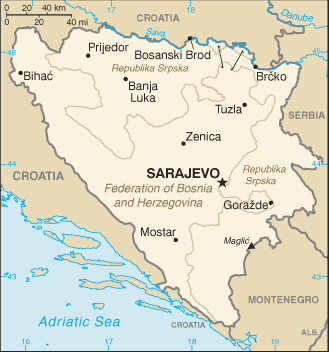|
Bosnia and Herzegovina
|

|
Capital: Sarajevo
Population: 3,301,000
Brief History of Bosnia and Herzegovina:
The area that is currently the country of Bosnia and Herzegovina was once part of the Roman Empire. When the Roman Empire collapsed, the region eventually developed into the kingdom of Bosnia. In 1463, Bosnia was taken over by the Ottoman Turks.
The Turks ruled in Bosnia until the late 1800s when it became part of Austria-Hungary. In 1908, Austria-Hungary officially annexed Bosnia to become a part of their country. Some of the people in southern Bosnia did not want to be part of Austria-Hungary.
Soon WWI broke out. After the war Bosnia became part of Yugoslavia. Things did not get any better for the Bosnians. During WWII many Bosnians were killed and persecuted.
After WWII, Yugoslavia became a communist country. Josip Broz Tito was the original leader for many years. He was followed by Slobodan Milosevic in 1986. This was a terrible time for the country. The different ethnic groups within Yugoslavia began to war with each other. The Bosnians wanted their own country and declared their independence on April 5, 1992. They were recognized as a country by the United Nations a month later.
Today there are three main ethnic groups that make up Bosnia and Herzegovina. They are Bosniaks, Serbs, and Croats. There are also three major languages including Bosnian, Serbian, and Croatian.
The Geography of Bosnia and Herzegovina
Total Size: 51,129 square km
Size Comparison: slightly smaller than West Virginia
Geographical Coordinates: 44 00 N, 18 00 E
World Region or Continent: Europe
General Terrain: mountains and valleys
Geographical Low Point: Adriatic Sea 0 m
Geographical High Point: Maglic 2,386 m
Climate: hot summers and cold winters; areas of high elevation have short, cool summers and long, severe winters; mild, rainy winters along coast
Major cities: SARAJEVO (capital) 392,000 (2009), Banja Luka, Tuzla
The People of Bosnia and Herzegovina
Type of Government: emerging federal democratic republic
Languages Spoken: Bosnian, Croatian, Serbian
Independence: 1 March 1992 (from Yugoslavia; referendum for independence was completed 1 March 1992; independence was declared 3 March 1992)
National Holiday: National Day, 25 November (1943)
Nationality: Bosnian(s), Herzegovinian(s)
Religions: Muslim 40%, Orthodox 31%, Roman Catholic 15%, other 14%
National Symbol: golden lily
National Anthem or Song: Drzavna himna Bosne i Hercegovine (The National Anthem of Bosnia and Herzegovina)
Economy of Bosnia and Herzegovina
Major Industries: steel, coal, iron ore, lead, zinc, manganese, bauxite, vehicle assembly, textiles, tobacco products, wooden furniture, tank and aircraft assembly, domestic appliances, oil refining
Agricultural Products: wheat, corn, fruits, vegetables; livestock
Natural Resources: coal, iron ore, bauxite, copper, lead, zinc, chromite, cobalt, manganese, nickel, clay, gypsum, salt, sand, forests, hydropower
Major Exports: metals, clothing, wood products
Major Imports: machinery and equipment, chemicals, fuels, foodstuffs
Currency: marka (BAM)
National GDP: $31,570,000,000
** Source for population (2012 est.) and GDP (2011 est.) is CIA World Factbook.
Back to Geography Home Page
